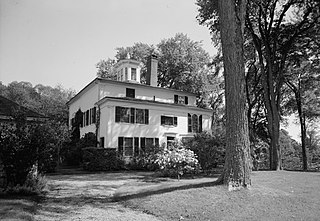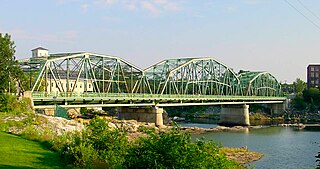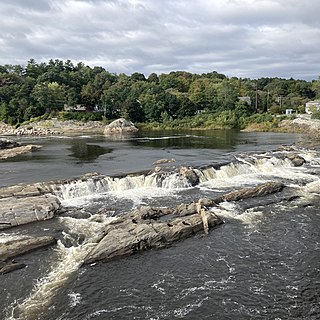
A fire engine is a road vehicle that functions as a firefighting apparatus. The primary purposes of a fire engine include transporting firefighters and water to an incident as well as carrying equipment for firefighting operations in a fire drill. Some fire engines have specialized functions, such as wildfire suppression and aircraft rescue and firefighting, and may also carry equipment for technical rescue.

Brunswick is a town in Cumberland County, Maine, United States. The population was 21,756 at the 2020 United States Census. Part of the Portland-South Portland-Biddeford metropolitan area, Brunswick is home to Bowdoin College, the Bowdoin International Music Festival, the Bowdoin College Museum of Art, the Peary–MacMillan Arctic Museum, and the Maine State Music Theatre. It was formerly home to the U.S. Naval Air Station Brunswick, which was permanently closed on May 31, 2011, and has since been partially released to redevelopment as "Brunswick Landing".

The Androscoggin River is a river in the U.S. states of Maine and New Hampshire, in northern New England. It is 178 miles (286 km) long and joins the Kennebec River at Merrymeeting Bay in Maine before its water empties into the Gulf of Maine on the Atlantic Ocean. Its drainage basin is 3,530 square miles (9,100 km2) in area. The name "Androscoggin" comes from the Eastern Abenaki term /aləssíkɑntəkw/ or /alsíkɑntəkw/, meaning "river of cliff rock shelters" ; or perhaps from Penobscot /aləsstkɑtəkʷ/, meaning "river of rock shelters". The Anglicization of the Abenaki term is likely an analogical contamination with the colonial governor Edmund Andros.

The Halifax Regional Water Commission (HRWC), publicly known as Halifax Water, is the municipal water, wastewater and stormwater utility serving the residents of the Halifax Regional Municipality (HRM), pursuant to the Public Utilities Act. An autonomous, self-financed utility, Halifax Water is a fully metered water utility providing water, fire protection, wastewater and stormwater services as regulated by the Nova Scotia Utility and Review Board.

The Androscoggin Swinging Bridge is a pedestrian suspension bridge spanning the Androscoggin River in Maine between the towns of Topsham in Sagadahoc County and Brunswick in Cumberland County. The bridge was built in 1892 as a timesaving approach for employees of the Cabot Manufacturing Company of Brunswick, could have safer and easier passage across the river.

Greater Mexico City, a metropolitan area with more than 19 million inhabitants including Mexico's capital with about 9 million inhabitants, faces tremendous water challenges. These include groundwater overexploitation, land subsidence, the risk of major flooding, the impacts of increasing urbanization, poor water quality, inefficient water use, a low share of wastewater treatment, health concerns about the reuse of wastewater in agriculture, and limited cost recovery. Overcoming these challenges is complicated by fragmented responsibilities for water management in Greater Mexico City:

The Pejepscot Paper Company mill building is a historic paper mill located off U.S. 201 in Topsham, Maine, on the banks of the Androscoggin River, adjacent from Brunswick Falls and the Frank J. Wood Bridge. Built in 1868, the building is one of the oldest surviving paper mills in the state of Maine. The mill was added to the National Register of Historic Places on September 17, 1974, and is now a mixed-use commercial property, housing the Sea Dog Brewing Company.

Water storage is a broad term referring to storage of both potable water for consumption, and non potable water for use in agriculture. In both developing countries and some developed countries found in tropical climates, there is a need to store potable drinking water during the dry season. In agriculture water storage, water is stored for later use in natural water sources, such as groundwater aquifers, soil water, natural wetlands, and small artificial ponds, tanks and reservoirs behind major dams. Storing water invites a host of potential issues regardless of that water's intended purpose, including contamination through organic and inorganic means.

Topsham is a town in Sagadahoc County, Maine, United States. The population was 9,560 at the 2020 census. It is part of the Portland–South Portland–Biddeford, Maine metropolitan statistical area. The town is home to the annual Topsham Fair.

The Brunswick Commercial Historic District encompasses the historic late-19th century commercial core of Brunswick, Maine. It includes the northern four blocks of Maine Street, the town's principal commercial thoroughfare, which was laid out in the late 17th century. The district was listed on the National Register of Historic Places in 2016.

The Cathance Water Tower is a historic water tower at Cathance Road and Beechwood Drive in Topsham, Maine. Probably built in the late 19th century, it is an extremely rare surviving example of a residential wooden water tower built for a single residence. It was listed on the National Register of Historic Places in 2001. It is now owned by the town.

The Topsham Historic District encompasses the historic village center of Topsham, Maine. Extending along parts of Elm, Green, and Pleasant Streets, the area has a fine collection of 19th and early 20th-century architecture, with the majority built before 1850. It is almost entirely residential, with only a few non-residential uses, including a church. The district was listed on the National Register of Historic Places in 1978.

The Des Moines Water Works (DMWW) is a publicly owned, municipal water utility with its headquarters in Water Works Park. It was founded 1871 southwest of downtown Des Moines, Iowa, along the Raccoon River and provides water to half a million residents of the greater Des Moines metropolitan area. As of 2017, it has three treatment facilities.

The Frank J. Wood Bridge is a three span, through truss bridge crossing over the Androscoggin River between the towns of Topsham and Brunswick, Maine, on U.S. Route 201. Opened in 1932, the bridge was originally called the Brunswick-Topsham bridge but was officially renamed the Frank J. Wood Bridge, after a local farmer who suggested the location.

Fort Andross, also known as Fort George and Cabot Mill, originally was a historic trading post and garrison built by the colonial British Empire to fortify against the Wabanaki Native Americans who were aligned with France during King William's War (1688–1697). It was adjacent to Brunswick Falls on the Androscoggin River in Brunswick, Maine. In the 19th century, the location of the fort has been used for several cotton mills including the Cabot Manufacturing Company. In 1986, the mills were transformed into office and retail space and renamed Fort Andross.

Pejepscot is a historical settlement first occupied by a subset of the Androscoggin Native Americans known as the Wabanaki. The region encompasses the current towns of Brunswick, Topsham and Harpswell, Maine in Sagadahoc and Cumberland counties and was first settled by English settlers in 1628.
Thomas Purchase (1577–1678), also known as Thomas Purchis and Thomas Purchas, was the first English settler to occupy the region of Pejepscot, Maine in what is now Brunswick, Topsham and Harpswell. In 1628 he set up a trading post at the site of Fort Andross to barter with the local Wabanaki Native Americans.

Brunswick Falls, also known as Pejepscot Falls, lie on a rocky section of the Androscoggin River, bordering the towns of Brunswick and Topsham, Maine in the US. First occupied by Paleoindians and the Wabanaki Native Americans, the falls were a plentiful resource for food and trade. Throughout colonial history, the Industrial Revolution, and into the 21st century, the falls have been a vital part of Brunswick and Topsham's economy, harnessing its power for energy development.

George Augustus Wheeler, MD was a surgeon in the American Civil War and a prominent Maine historian. He authored two historical books including History of Brunswick, Topsham, and Harpswell, Maine, which the Pejepscot Historical Society states as the "authoritative text on the three towns through 1878".

The Pejepscot Proprietors was a company of land investors who colonized the current towns of Brunswick, Topsham and Harpswell, Maine, between 1715 and 1814.




















